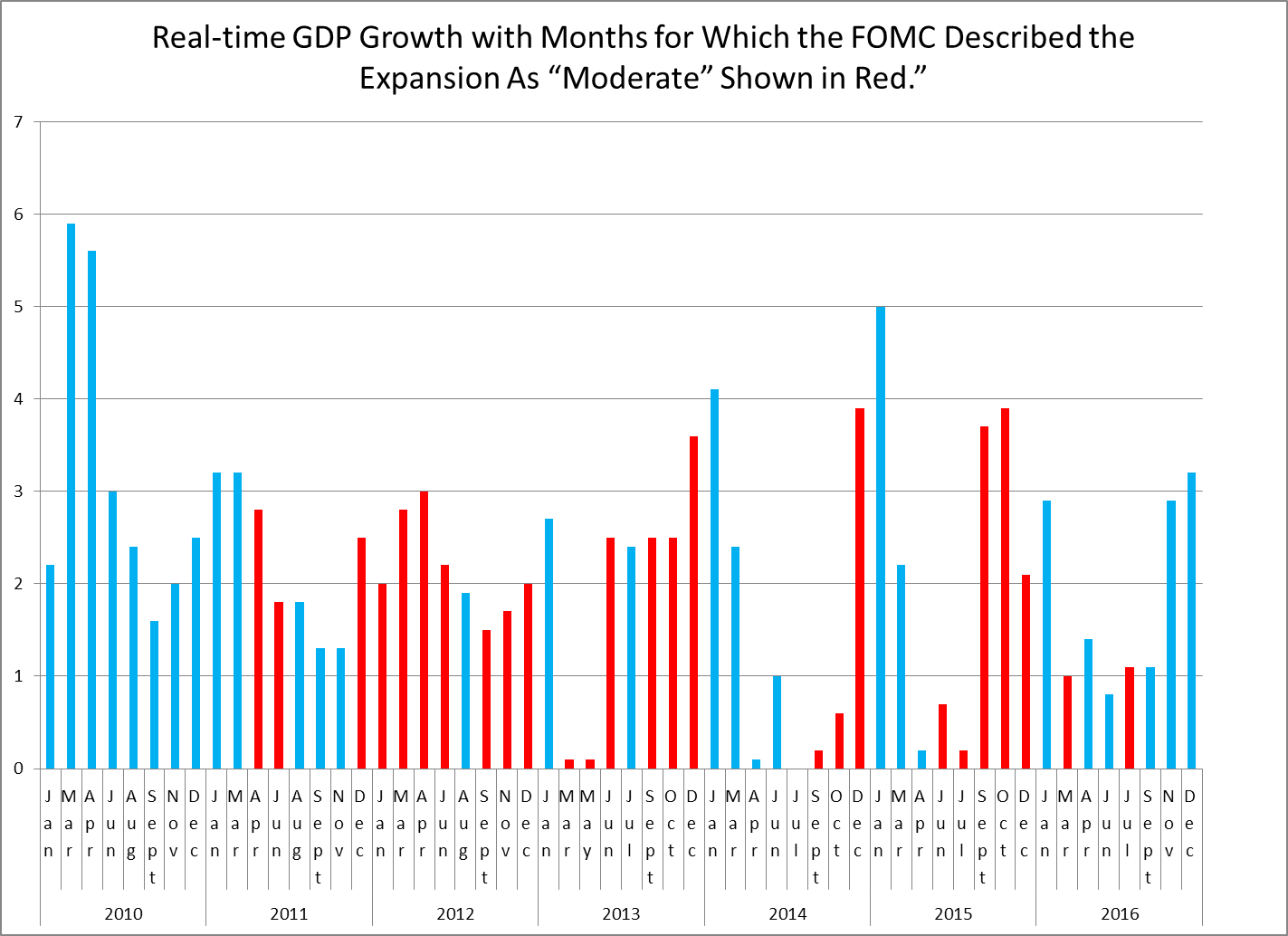The FOMC has both experimented and struggled with its communications policy since it first began announcing its decisions in 1994. It has established numerous subcommittees to review its communications and make recommended changes, beginning with the subcommittee chaired by then-Vice-Chair Roger Ferguson. During and in the aftermath of the financial crisis, communications became a central tool of policy making.
The Committee has sought to use both its statements and its press conferences to provide forward guidance to markets as a way to affect behavior and market expectations. The process has met with mixed success, in part because the message keeps changing. Witness the evolution of the FOMC’s statements in 2009. In January the Committee began to provide some forward guidance when it indicated that it expected to keep rates low “for some time.” In March the committee tweaked the wording to read “extended period.” That wording persisted until the Committee’s August 2011 statement, when it modified the language to provide a more specific time period, indicating that it expected rates to remain low “at least through mid-2013.” This wording didn’t remain in place for long: It was changed in January 2012 to read “at least through late 2014,” and was extended to “through mid-2015” in August 2012.
In its December 2012 statement the Committee abandoned its date-specific guidance and substituted specific unemployment and inflation objectives in its place. The Committee stated that it intended to keep rates low:
“...as long as the unemployment rate remains above 6-1/2 percent, inflation between one and two years ahead is projected to be no more than a half percentage point above the Committee’s 2 percent longer-run goal, and longer-term inflation expectations continue to be well anchored.”
However, unemployment promptly dropped below 6.5% in April 2014, though inflation remained well below the 2% objective for the PCE. So the Committee promptly dropped the unemployment objective in its April 2014 statement and tied the duration of its low-rate policy to the ending of its asset purchase program and inflation objective, stating that it would keep rates low “for a considerable time after the asset purchase program ends, especially if projected inflation continues to run below the Committee’s 2 percent longer-run goal, and provided that longer-term inflation expectations remain well anchored.” The Committee finally gave up on providing meaningful forward guidance in January 2015, resorting to a statement that could be distilled into two words, indicating that policy would be “data dependent.”
The Committee’s lack of success in crafting a durable forward-guidance communications policy that it was both willing and able to stand by and deliver on credibly gives credence to the argument that former Federal Reserve Bank of Philadelphia President Charles Plosser has made on numerous occasions. That is, the FOMC has repeatedly opted to retain its discretion to act rather than committing to a future path and credibly delivering on that commitment.
The theoretical literature concerning the efficacy of forward guidance has established that it requires both commitment and delivery, but in reality policy makers are understandably reluctant to stay the course when underlying facts change and forecasts are not realized. This is a case where, when theory breaks down in the face of reality, something is wrong with the theory.
Not only has the FOMC had a problem with implementation of forward guidance, it has also compounded its communications problems by using code words that lack both well-understood definitions and consistency. Jeffrey Sparshott has addressed two critically important words, modest and moderate, typically used by the FOMC in one of its opening sentences to describe the performance of the economy
He looked at the period from January 2011 to July 2013 and concluded that moderate suggested that the economy was expanding at about a 2% pace, while modest was meant to suggest a pace somewhat below that. Expanding the time period from 2010 through the FOMC’s last statement in November 2016 can help shed some light on how the use of the term moderate conveys almost no useful information about how the FOMC actually sees the economy progressing.
The FOMC has used the word moderate to describe the pace of economic activity about 26 times from 2010 through the present. Using the real-time estimate of real GDP growth available to the FOMC at each of its meetings, the mean GDP annualized growth for the period was 2.03%, but the standard deviation was 1.12 percentage points, suggesting that there was no consistency in how the FOMC viewed the expansion. The time pattern of the use of the word is better viewed in the context of the time pattern of FOMC decisions, shown in the figure below. It plots real GDP growth at each meeting, with the times the word moderate was used to describe growth highlighted in red.
The Committee used the word for the first time in April 2011, when growth was 2.8%, and again in June 2011, when growth was 1.8% for Q1 2011. Interestingly, growth for Q2 2011, which again was 1.8%, was described in the Committee’s June statement as considerably slower than the Committee expected. In this message, the Committee shifted from describing the expansion to describing how it compared to what the Committee had expected. Oddly, in September 2011, when growth was 1.3%, the Committee stated that the pace had slowed, but when it looked at the identical number, 1.3%, for Q3 2011, the Committee stated that growth had strengthened somewhat.
Even more contradictory was the Committee’s characterization of growth in its 2013 March and May statements. Growth of 0.1% for both Q4 2012 and Q1 2013 was described as moderate, followed by moderate characterizations of growth that was well in excess of 2.5% at each of its next four meetings. Following its December 2013 statement in which it characterized the 3.6% increase in real GDP as moderate, the Committee described the 4.1% increase in GDP it had before it in Jan 2014 as having “picked up.” Here the Committee switched from describing GDP growth to comparing it with the previous quarter (ie. the second derivative).
What we can observe is both lack of precision with how it describes the pace of economic activity in its statements and sometimes comparing growth to previous periods or to Committee expectations. The FOMC would help its readers if it sought to provide consistent and rather tight relationships between the statistics it describes and the words it uses. We can’t shed much light on what the word modest might mean, since it has been used only three times –in July 2013 when growth was 2.4% and in September and November of 2016 when GDP growth was 1.1% for Q2 2016 and 2.9% for Q3 2016.
The FOMC’s December statement will be carefully parsed, especially since it will likely announce a rate increase and feature words describing the future path of policy. Until the FOMC cleans up its rhetoric, however, its linguistic efforts are not likely to prove helpful.
